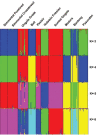Genetic diversity of Indonesian cattle breeds based on microsatellite markers
- PMID: 30145876
- PMCID: PMC6409462
- DOI: 10.5713/ajas.18.0283
Genetic diversity of Indonesian cattle breeds based on microsatellite markers
Abstract
Objective: This research was conducted to study the genetic diversity in several Indonesian cattle breeds using microsatellite markers to classify the Indonesian cattle breeds.
Methods: A total of 229 DNA samples from of 10 cattle breeds were used in this study. The polymerase chain reaction process was conducted using 12 labeled primers. The size of allele was generated using the multiplex DNA fragment analysis. The POPGEN and CERVUS programs were used to obtain the observed number of alleles, effective number of alleles, observed heterozygosity value, expected heterozygosity value, allele frequency, genetic differentiation, the global heterozygote deficit among breeds, and the heterozygote deficit within the breed, gene flow, Hardy-Weinberg equilibrium, and polymorphism information content values. The MEGA program was used to generate a dendrogram that illustrates the relationship among cattle population. Bayesian clustering assignments were analyzed using STRUCTURE program. The GENETIX program was used to perform the correspondence factorial analysis (CFA). The GENALEX program was used to perform the principal coordinates analysis (PCoA) and analysis of molecular variance. The principal component analysis (PCA) was performed using adegenet package of R program.
Results: A total of 862 alleles were detected in this study. The INRA23 allele 205 is a specific allele candidate for the Sumba Ongole cattle, while the allele 219 is a specific allele candidate for Ongole Grade. This study revealed a very close genetic relationship between the Ongole Grade and Sumba Ongole cattle and between the Madura and Pasundan cattle. The results from the CFA, PCoA, and PCA analysis in this study provide scientific evidence regarding the genetic relationship between Banteng and Bali cattle. According to the genetic relationship, the Pesisir cattle were classified as Bos indicus cattle.
Conclusion: All identified alleles in this study were able to classify the cattle population into three clusters i.e. Bos taurus cluster (Simmental Purebred, Simmental Crossbred, and Holstein Friesian cattle); Bos indicus cluster (Sumba Ongole, Ongole Grade, Madura, Pasundan, and Pesisir cattle); and Bos javanicus cluster (Banteng and Bali cattle).
Keywords: Cattle Breed; Genetic Diversity; Indonesian; Microsatellite.
Conflict of interest statement
We certify that there is no conflict of interest with any financial organization regarding the material discussed in the manuscript.
Figures





References
-
- Sutarno, Setyawan AD. Review: Genetic diversity of local and exotic cattle and their crossbreeding impact on the quality of Indonesian cattle. Biodiversitas. 2015;16:327–54.
-
- MARI (Ministry of Agriculture Republic Indonesia) Directorate of animal breeding and production. [cited 2018 June 12]. Available from: http://bibit.ditjenpkh.pertanian.go.id/jenis-rumpun/sapi.
-
- Said S, Putra WPB, Anwar S, Agung PP, Yuhani H. Phenotypic, morphometric characterization and population structure of Pasundan cattle at West Java, Indonesia. Biodiversitas. 2017;18:1638–45.
-
- Rehman MS, Khan MS. Genetic diversity of Hariana and Hissar cattle from Pakistan using microsatellite analysis. Pakistan Vet J. 2009;29:67–71.
Grants and funding
LinkOut - more resources
Full Text Sources
Other Literature Sources

